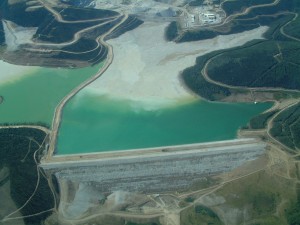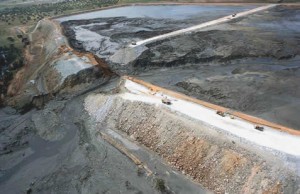Rainfall is a critical factor in how effectively mining waste can be contained. When copper is separated from the rock we are left with tailings. Tailings are fine waste rock particles suspended in water.
How tailings are generated
The usual method for separating waste rock from the commercial mineral (and the method that would be used in Intag) is called froth flotation.
First ore goes through the grinding mill, where it is crushed into a fine powder. This powder is mixed with water to form a thick sludge. Then a chemical is added that causes the copper element to be repulsed by water. Air is blown into the liquid to produce bubbles and, repelled by water, the copper adheres to the bubbles while the waste rock drops to the bottom of the tank. This waste rock, the tailings, consists of huge amounts of fine waste rock particles suspended in water.
Tailings dams
Our 21st century solution for storing millions of tons of toxic waste is to dam it into massive shallow swimming pools called tailings ponds.
Tailings can be particularly toxic since the rock particles are so fine, so a very large surface area of rock is exposed. As soon as rock is exposed to oxygen the waste begins to generate acid. Click here for an explanation of how waste turns toxic. The result is millions of tons of waste rock and water laced with arsenic and heavy metals contained behind a dam that needs to stand forever.
Dam failure
We are often told to put our faith in technology, but our technology has its limits. There has been at least one major tailings dam failure per year since 20014. These failures are not limited to old technology or poor regulations. 39% of reported failures occur in the US5. Most occur at currently operating mines.
Heavy rainfall makes it very hard to regulate water levels in tailings pools. The most common cause of dam failure is ‘overtopping.’ Water levels exceed the height of the dam, hundreds of thousands of tons of toxic waste spill into the environment.
Some recent disasters-
- 2011, Songpan county, China – A tailings dam was damaged by landslides caused by heavy rain. The tailings displaced 272 people and washed into the Fujiang River, leaving 200,000 people without drinking water.
- 2010, Kolontár, Hungary – A tailings dam storing waste from bauxite mining collapsed due to heavy rain. Thousands of tons of toxic mud flooded an area of 8km2 and several towns, killed 10 people and injured 120.
- 2012, Manila, Philippines – 20 million tons of mine waste was released into the environment after a dam failure. The Balog river was left biologically dead. Philex mining corporation claimed they had not breached environmental regulations. The abnormally heavy rains, they claim, were an ‘act of God.’
A long list of tailings dam failures can be found here. The list is not comprehensive.
back to WHY NO >>
- Sources:
- “Mining Industry Profile: Copper” US Environmental Protection Agency http://www.epa.gov/osw/nonhaz/industrial/special/mining/techdocs/copper/copper1b.pdf
- In depth information on tailings http://www.tailings.info/index.htm
- Wikipedia entry froth flotation http://en.wikipedia.org/wiki/Froth_flotation
- “Tailings Dams Risk of Dangerous Occurrences: Lessons learnt from practical experiences” International Commission On Large Dams(ICOLD) http://www.unep.fr/shared/publications/pdf/2891-TailingsDams.PDF
- “Long term risks of tailing dam failure” http://www.csp2.org/files/reports/Long%20Term%20Risks%20of%20Tailings%20Dam%20Failure%20-%20Chambers%20%26%20Higman%20Oct11.pdf
- PBS article on tailings dams
http://www.pbs.org/wgbh/pages/frontline/environment/alaska-gold/tailings-dams-where-mining-waste-is-stored-forever/ - Chronology of major tailings dam failures http://www.wise-uranium.org/mdaf.html


